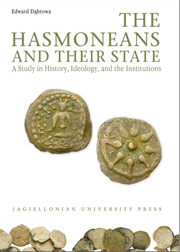Book contents
- Frontmatter
- Contents
- Introduction
- Abbreviations
- Part I Judea under the Hasmoneans (167–63 BCE)
- Part II The Institutions of the Hasmonean State
- I The Ruler
- II The State
- I Local Administration
- 2 Finances
- 3 Army
- Part III Society
- Conclusions
- Bibliography
- Index of Personal Names
- Index of Place Names
- Index of Ancient Sources
- Electrum - Volumes Published
- The Hasmonean State
2 - Finances
from II - The State
Published online by Cambridge University Press: 05 September 2014
- Frontmatter
- Contents
- Introduction
- Abbreviations
- Part I Judea under the Hasmoneans (167–63 BCE)
- Part II The Institutions of the Hasmonean State
- I The Ruler
- II The State
- I Local Administration
- 2 Finances
- 3 Army
- Part III Society
- Conclusions
- Bibliography
- Index of Personal Names
- Index of Place Names
- Index of Ancient Sources
- Electrum - Volumes Published
- The Hasmonean State
Summary
As to the first Hasmoneans' financial resources, we know that they were large enough to support an army, build and expand necessary military installations, reward members of their close circle, and implement a limited social policy. Their income was so vast that despite all Simon's expenditure, late in his reign he possessed a fortune which, even though difficult to estimate, truly astonished Antiochus VII Sidetes' envoy as he visited the Judean ruler in Jerusalem (cf. 1 Macc 15:32. 36).
Probably much of the treasury inherited from Simon was spent by John Hyrcanus in his first years on the throne to cover costs incurred in a defeat at the hands of Antiochus VII Sidetes and to finance his forced participation in the Parthian expedition of this king. Sources suggest, however, that within more than a decade he had not only recovered those losses, but had taken advantage of favorable political circumstances to greatly multiply his resources. From John Hyrcanus until the loss of Judean independence in 63, the Hasmoneans never had to face serious financial problems. This brings us to the sources of their wealth. We know that during the intense fighting by the first Hasmoneans against Syrian rulers, much of their revenue came from plundering the areas where their army operated, seizure of property belonging to Hellenists, and taxes payable by Judeans to the Seleucids but intercepted in part or in whole by the Hasmoneans to finance their own needs.
- Type
- Chapter
- Information
- The Hasmoneans and their StateA Study in History, Ideology, and the Institutions, pp. 152 - 158Publisher: Jagiellonian University PressPrint publication year: 2009



